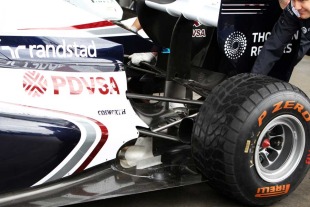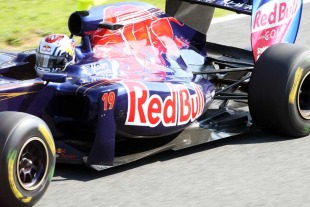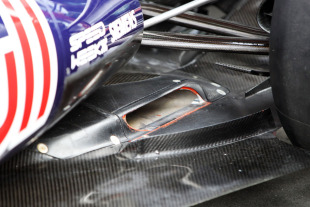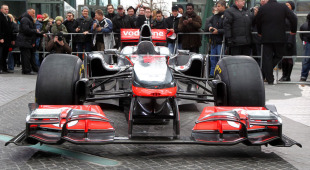- GP Week
F1: In vogue
A new season means a new collection of grand prix cars, all ready to do battle on the world stage of Formula One racing. In a special feature, GP Week takes a look at the major innovations on the 2011 grid, and explains in layman's terms why teams have gone so radical.

- Teams:
- McLaren
- |
- Red Bull
- |
- Renault
- |
- Toro Rosso
- |
- Williams
The ban on the innovative double decker diffuser over the winter has seen many radical innovations on the cars for 2011, as teams scramble to recoup the lost downforce. With no double diffuser to create extra grip, teams have had to spend precious time and money perfecting the way their conventional diffusers work to help extract every last tenth from the current regulations.
A number of teams have taken radical steps to achieve maximum performance from their diffusers, all achieving the same aim but in different ways. Renault, Toro Rosso, Williams and Red Bull have all stood out from the crowd in 2011, while McLaren had been hoping to stand out with their innovative exhaust before pulling it from the car for Melbourne.
The target for all teams has been to improve the airflow to the rear of the car, and hence diffuser, to ensure the speed of the air underneath the car is as fast as possible to create more downforce from the diffuser. By speeding up the air, the pressure is reduced sucking the car onto the ground and making it stick through the corners. Some teams have tried to speed the air up under the floor itself, while others have tried to suck the air out through the diffuser more quickly to achieve the same overall effect, albeit less efficiently. Let's take a look at the major innovations for 2011, beginning with Renault's radical exhaust.
Renault

Their exhaust route would have caused some major cooling headaches and is the main reason why other teams have not come up with similar designs. Getting the 900-degree gases to be channelled through an already cramped space under the radiator and near the fuel tank was no easy task, but the potential benefits are huge.
The team's performance in Melbourne suggests the car has the pace, but races with hotter climates such as Malaysia may prove less straight-forward. Highlighting just how beneficial Renault's frontexiting exhausts could be, Mercedes GP team principal Ross Brawn said the performance advantage from it has the potential to be larger than the double diffuser.
"It is a significant area and maybe more significant than the double diffuser in terms of performance and of course the teams are all working with their engine partners to work out how to get the most out of the exhaust energy so that is the new interesting area of development," Brawn explained.
Toro Rosso

The STR6 is another radical car on the 2011 grid, featuring a so-called 'double floor'. The design team have lifted up the sidepods to allow a clean flow of air above the floor to increase diffuser performance. Instead of having to go around, the air simply goes under the sidepods to enjoy an unhindered route to the diffuser. Having a cleaner airflow to the diffuser allows more air to be sucked out, increasing downforce.
Williams
Williams have gone radical with the rear of their car, focusing all their effort on a massively slimmed down gearbox casing. The innovation has allowed Williams to vastly improve the flow of air to the diffuser, by removing the highest part of the gearbox that would otherwise disrupt the flow and affect diffuser performance. There is now a large gap just forward and above the rear axle where the top of the gearbox used to be, a feature that would have dramatically affected the flow of air to the centre of the diffuser. It also allows a cleaner flow of air to the lower rear wing, the small wing just above the rear axle which also helps suck air from the diffuser. The approach will not be easy to copy if it is found to be effective however, as a brand new gearbox design takes months to develop."The main target was to clear all the area to the rear lower wing because it is a performance differentiator now," said technical director Sam Michael. "You've got to have the underside of the rear lower wing completely free, so we took the decision to lift the top wishbone and the track rod and go to a Z-bone layout - which was commonly used in the early 90's - to get that all above the underside. It means that all the weight is in line with the trailing edge of the legality box, so you are nowhere near the underside of the rear lower wing, and it's completely free airflow."
Red Bull

Having pioneered the exhaust blown diffuser last year, Red Bull are back for more in 2011 with another version of a blown exhaust. While the rules don't allow for an extreme design as we saw last year where the exhaust exited directly into the diffuser, Red Bull now have their exhaust exiting at the trailing edge of the floor just before the rear tyres to effectively operate as a blown diffuser (see pic above right). The new regulations don't allow holes in the diffuser any more, but Red Bull have circumvented that rule by having the gas exit at the edge of the floor just forward of the diffuser.
McLaren
The MP4-26 is definitely the most radical-looking car on the 2011 grid, with U-shaped sidepods being a brand new addition to Formula One. The strange-looking sidepods allow the least turbulent air between the wheels to enjoy an unhindered route to the rear of the car where the cleaner flow helps create more downforce at the diffuser, while the turbulent flow around the wheels is fed into the radiators to cool the engine.Packaging constraints would limit other teams in adopting the design, as would cooling requirements. Another innovation on the launch specification McLaren was its radical exhaust. While most exhausts exit through two large outlets, McLaren's exhaust was believed to have comprised a multitude of outlets, allowing them to more finely tune the exhaust flow into the diffuser, thereby making more efficient use of the gases.

The radical design would have caused problems with engine tuning among other things, and McLaren had to ditch it before the first race due to reliability problems. The team would have completed a risk study on the radical exhaust, weighing up the potential of it failing versus the advantage it would deliver when working properly. As the probability of it not working was considerably high, the lap time advantage would have been exceptional. It's possible that they will return to the idea later in the season. Prior to jetting off to Melbourne, McLaren removed the radical exhaust system in favour of a more conventional design. The design is very similar to Red Bull's, with the gases exiting at the end of the floor in front of the rear tyres.
Team principal Martin Whitmarsh explained that their radical exhaust hadn't delivered sufficient benefit, likely pointing to as yet unrealised potential: "I think the exhaust systems have become quite extreme on quite a lot of the cars. I think we in particular had very extreme solutions. But I think that they were not delivering, in my opinion, sufficientbenefits for their complexity," said Whitmarsh. "I believe that the car isn't fundamentally a bad car. I believe that we need to unlock the exhaust-blowing potential."

